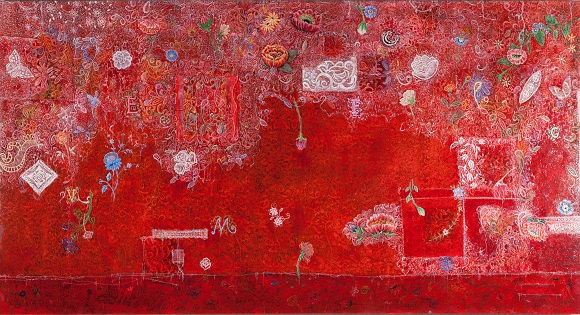Summary |
A research project uses painting to explore the untold narratives associated with dowry objects. |
|---|---|
Start Date |
Feb 24, 2018 12:00 pm |
End Date |
Mar 7, 2018 5:00 pm |
Venue |
Plimsoll Gallery |
Memory Stitches: a Painterly Exploration of Migratory Dowry

Image credit: Elizabeth Lada Gray, As breath, oil on linen, 80 x 150cm, 2017. Image courtesy the artist.
Opening event: Friday 2 March 2018, 5.30 – 7.00 pm
Exhibition dates: Saturday 24 February – Wednesday 7 March, 2018
Gallery Hours: Wed - Mon 12pm - 5pm (during exhibitions)
Closed Tuesdays and Public holidays
Abstract
This research project uses painting to explore the untold narratives associated with dowry objects belonging to post Second World War migrant women who reside in Tasmania. It has aimed to transpose dowry items from precious objects, hidden from everyday view, into a series of painted images that evoke the complex cultural, historical and personal significance of dowry. Based on interviews with migrant women about their dowry, the project has reassessed the meaning and importance of dowry as a significant aspect of migration history in Tasmania. It interprets migratory dowry through the key themes of history, culture, memory, nostalgia and loss, and gives recognition to a cultural practice that is gradually declining.
Traditional European matrilineal dowries were the material foundation for the establishment of a new family, and represented the continuation of cultural heritage, social status and bride-wealth. They were commonly comprised of everyday domestic objects such as woven, stitched and embroidered tablecloths and bed linen. Motivated by the personal stories attached to dowry and my own emigration story, I have created a suite of paintings that aim to challenge the perception that dowry has become a mere token of the migration experience.
The context of the project has been informed by the work of artists who have explored migration experiences, cloth and stitching in their Still Life genre practice. These include Rachel Ruysch’s historical paintings of floral imagery, Alison Watt’s contemporary representations of folded and textured cloths, Aleks Danko’s paintings of stitched cultural patterns and Elisa Markes-Young’s mixed media works that incorporate thread. These and other artists have created works about cloth, stitching and migration, however, my research has specifically focussed on the dowry objects of Tasmanian migrants.
Key texts that informed the research include Roszika Parker’s history of embroidery, Maria Tence and Elizabeth Triarico’s explanation of European dowry customs and Edvige Giunta and Joseph Sciorra’s interpretations of the symbolism of botanical and geometric embroidery adornment. Ilaria Vanni explores the role dowry objects played in migrant resettlement and Margaret Gibson reflects on memory and biography embedded in personal objects. These authors explain how the key concepts of memory, nostalgia, loss and migration are attached to dowry, and also confirm the decline of migratory dowry, which reinforced my commitment to the project and gave it a sense of urgency.
The thesis paintings depict the embroidered dowry linen objects of Tasmanian migrant women, using linen as a substrate to reinforce the materiality of dowry, a paint-for-stitch process to replicate embroidery techniques and a focus on the figure-ground relationship to emphasise individual dowry motifs. As these and other strategies progressed, the paintings became more complex to convey the layering of memory and nostalgia associated with dowry and the waning of dowry practices. The thesis demonstrates that painting can powerfully evoke the multiplicity of meanings embedded in dowries.